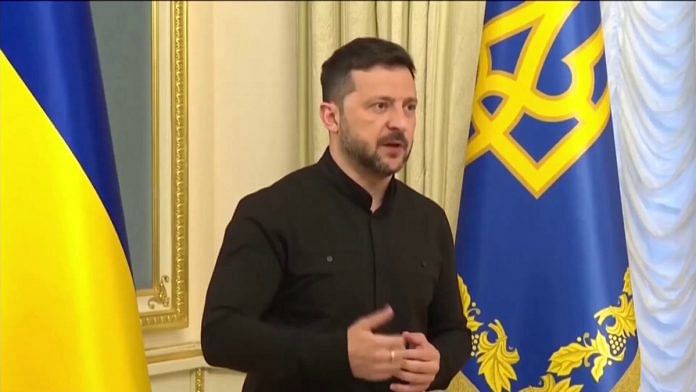Regardless, Russia’s reputation has taken a profound hit.
When US President Donald Trump publicly dismissed Ukrainian President Volodymyr Zelenskyy during the awkward Oval Office spat—mocking Ukraine for “not holding any cards”—few could have imagined that Zelenskyy’s team had been quietly orchestrating their most daring military operation yet. Less than four months after that diplomatic misstep, Ukraine has not only secured a “minerals deal” with the US but also claimed a newfound strategic independence. For a nation heavily outgunned, stretched thin on ammunition and air defence, this attack marks a bold assertion of agency and resilience.
Called Operation Spider’s Web, the afternoon of 1 June saw stunning footage of low-cost Ukrainian FPV drones—averaging just $450 each—devastating Russian airfields. While initial reactions were clouded by the fog of narratives, geolocated video evidence swiftly confirmed the strikes.
President Zelenskyy announced the operation as a fully Ukrainian endeavour, subtly rebuking Trump’s earlier claim that Ukraine couldn’t stand without US support. The operation has reshaped military perceptions to a fair extent, even if its role in changing the outcome remains unconvincing.
Though Russia has acknowledged some attacks on its bases, it has downplayed the extent—repelling hits on Ivanovo, Ryazan, and Amur airfields. Yet with today’s transparent, geolocated battlefields such details rarely stay hidden for long.
As always, the devil lies in the details. According to Ukraine’s Security Service (SBU), the recent drone offensive—Operation Spider’s Web—struck an estimated 41 aircraft classified as strategic bombers, including the powerful Tu-95 and Tu-22 M, along with an A-50 AWACS (Airborne Warning and Control System) plane. Strategic bombers are long-range aircraft capable of delivering large-scale air-to-ground weaponry, including both conventional and nuclear payloads. Unlike fighter jets, which prioritise speed and manoeuvrability, these bombers are designed to carry huge quantities of weapons over extended distances, which made them central to Cold War era nuclear muscle flexing.
The reported destruction of 41 such aircraft—roughly one-third of Russia’s 100-strong strategic bomber fleet—across five airfields marks a dramatic escalation. In Kyiv, the operation is seen as retribution for months of Russian airstrikes targeting Ukrainian civilians and infrastructure, often delivered by the same Tu-95s and Tu-22s.
Among the most symbolic strikes was the one on Olenya Air Base in Murmansk, near the Russia-Finland border—now also the NATO frontier since Finland’s accession in 2023. Once protected by Finnish neutrality during the Cold War, Russia’s Kola Peninsula, home to key assets of its nuclear arsenal, now finds itself within reach of Ukrainian drones. Also hit in the region was Severomorsk, the administrative centre of Russia’s Northern Fleet and a key submarine base.
Another high-value target was Belaya Air Base in the Irkutsk region, a staggering 4,300 kilometres from the Ukrainian border. Belaya hosts several elite units, including the 200th Guards Heavy Bomber Regiment and the 444th Heavy Bomber Regiment, both operating Tu-22M3 bombers, as well as transport squadrons flying Antonov aircraft.
Additional drone strikes hit Ivanovo Air Base in the Ivanovo region and Dyagilevo Air Base in Ryazan. A planned strike on Ukrainka Air Base was reportedly foiled by Russian air defences acting swiftly—one of the few interceptions in an otherwise devastating campaign.
The reported destruction of Russia’s strategic bombers—valued at an estimated $7 billion—marks not only a staggering financial loss but, more importantly, a profound blow to Russia’s military prestige and operational readiness. Unlike money, these assets cannot be quickly replaced. Both the Tu-22M and Tu-95 bombers are legacy aircraft, long out of production, making their loss difficult to recover from. Yet the more damning consequence may lie in the exposure of systemic vulnerabilities within Russia’s intel and security architecture. The failure of the Federal Security Service and short-range air defences to prevent a coordinated drone assault by a significantly smaller, outgunned adversary has raised uncomfortable questions about the efficacy of Russian intelligence and deterrence.
This attack comes at a critical juncture in the broader geopolitical narrative. With US President Trump increasingly echoing pro-Russian sentiments and Biden-era military aid to Ukraine set to by month’s end, momentum had been shifting in Moscow’s favour. President Putin, sensing this opportunity, has intensified efforts to seize Ukrainian territory and cripple critical infrastructure.
Yet, Ukraine’s stunning show of force through Operation Spider’s Web disrupts that trajectory.
Despite immense pressure, Ukraine has cultivated a highly adaptive domestic defence industry. The emergence of new political leadership in Germany, particularly Friedrich Merz’s firm support for Ukraine and constitutional amendments for freeing defence spending, has revitalised European backing. The coordinated support from France, the UK, and Poland reinforces Kyiv’s position, even as opposition lingers from Hungary and Slovakia.
Several key takeaways arise from this operation. First, Ukraine has demonstrated not only strategic agility but mastery over drone warfare, transitioning from localised, border-centric strikes to sophisticated deep-penetration attacks. Second, this is an embarrassment for Putin, whose carefully constructed image of an invincible, hyper-masculine Russia has been undermined. Third, the operation represents a breakthrough in asymmetric warfare, showcasing technological innovation on a global stage. Ukrainian startup Strategic Force Solutions has been producing GOGOL-M drone motherships capable of deploying GPS-independent FPV drones, signalling a leap forward in AI-enabled autonomous aerial warfare. Reportedly, these were very much a part of Operation Spider’s Web. This development will be and should be keenly studied by military and technological experts. These lessons are useful for all, including India’s evolving drone capabilities.
Lastly, this war is far from over.
The pressing question now is not whether Putin will respond, but how. While escalation is certain, it is unlikely to cross the nuclear threshold. Ukraine’s systematic targeting of strategic assets over the past three years—ranging from air defence systems and radars to killing Russian generals and attacking critical infrastructure—has revealed the limitations of Russia’s nuclear posturing. Moreover, a tactical nuclear strike could backfire politically, especially with a volatile Trump returning to the White House. Such a move might alienate even Trump’s ‘carrots to Russia and sticks to Ukraine’ approach—a strategic blunder for Putin. In a world still dominated by American economic and military influence, Russia cannot afford to miscalculate.
Even when Donald Trump’s oversimplification of the world and its woes continues to hamper meaningful resolutions to long-standing wars, the sheer weight and might of the American military and economy are such that Putin should not risk losing POTUS to a tactical nuke.
(Edited by Theres Sudeep)








